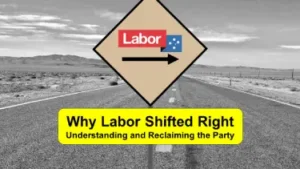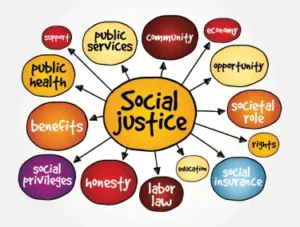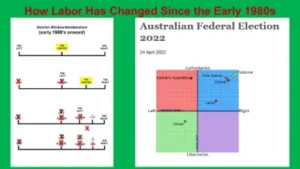
Description:
Explore Labor partys shift to right, the impacts, and strategies to return to its people-focused roots. Learn how Labor can reconnect with voters.
Introduction: The Changing Face of Labor
 The Australian Labor Party (ALP), once the voice of the working class, has undergone significant transformation over the past few decades. The party, which was founded on principles of social justice, workers’ rights, and public ownership, now finds itself often indistinguishable from its political rival, the Liberal-National Coalition (LNP). This shift to the right has left many traditional Labor supporters feeling alienated and disillusioned. Understanding the reasons behind this change is crucial for those who wish to see Labor return to its roots as a party for the people.
The Australian Labor Party (ALP), once the voice of the working class, has undergone significant transformation over the past few decades. The party, which was founded on principles of social justice, workers’ rights, and public ownership, now finds itself often indistinguishable from its political rival, the Liberal-National Coalition (LNP). This shift to the right has left many traditional Labor supporters feeling alienated and disillusioned. Understanding the reasons behind this change is crucial for those who wish to see Labor return to its roots as a party for the people.
1. Historical Context: Labor’s Origins and Early Ideals
A. Labor’s Foundation and Core Principles

The Australian Labor Party was set up in the 1890s, born out of the struggles of the working class. It was the party of the trade unions, committed to improving the lives of workers through policies that promoted fair wages, safe working conditions, and public ownership of essential services. The ALP’s early successes, such as the introduction of the eight-hour workday and the establishment of social welfare programs, solidified its reputation as the defender of the working class.
B. Key Milestones That Defined Labor’s Left-Leaning Stance
Throughout the 20th century, Labor remained committed to its core values. The introduction of Medicare, the expansion of the welfare state, and the protection of workers’ rights were hallmark achievements of a party that placed social justice at the forefront of its agenda. Labor’s commitment to these ideals made it a distinct alternative to the more conservative policies of the LNP.
C. First Tensions Between Progressive Ideals and Pragmatic Governance
Despite its strong ideological foundations, the Labor Party faced internal tensions from the start. Balancing progressive ideals with the practicalities of governance was a constant challenge. As Labor gained power at the federal level, it sometimes found itself compromising on key principles in the face of economic and political realities.
2. The Neoliberal Influence: Labor’s Shift Begins
A. The Global Rise of Neoliberalism
The late 20th century saw the rise of neoliberalism, an economic ideology that emphasized free markets, deregulation, and reduced government intervention in the economy. This global shift had a profound impact on political parties around the world, including the ALP.
B. Neoliberal Policies in the Hawke-Keating Era
 The Labor governments of Bob Hawke and Paul Keating in the 1980s and 1990s marked a significant turning point for the party. Faced with economic challenges such as inflation and high unemployment, these leaders adopted neoliberal policies, including financial deregulation, privatization of state-owned enterprises, and labor market reforms. While these policies were credited with modernizing the Australian economy, they also marked a departure from traditional Labor values.
The Labor governments of Bob Hawke and Paul Keating in the 1980s and 1990s marked a significant turning point for the party. Faced with economic challenges such as inflation and high unemployment, these leaders adopted neoliberal policies, including financial deregulation, privatization of state-owned enterprises, and labor market reforms. While these policies were credited with modernizing the Australian economy, they also marked a departure from traditional Labor values.
C. Key Reforms That Signalled the Shift Right
Key reforms during this period, such as the floating of the Australian dollar and the privatization of Qantas and the Commonwealth Bank, symbolized Labor’s embrace of neoliberalism. These decisions were seen as necessary to keep Australia competitive in a globalized economy but also alienated sections of the party’s traditional base who felt betrayed by the shift away from public ownership and control.
3. Economic Pressures and Political Pragmatism
A. Impact of Globalization and Economic Pressures
Globalization brought both opportunities and challenges to Australia. The decline of traditional manufacturing industries and the rise of the service economy changed the economic landscape. Labor, like many centre-left parties around the world, faced the challenge of adapting to these changes without abandoning its core supporters.
B. Electoral Pragmatism: Appealing to a Broader Voter Base

As the middle class grew, so did its importance in elections. Labor’s leadership recognized the need to appeal to a broader voter base, including middle-class voters who were more concerned with issues like economic stability and tax cuts than with traditional labor concerns. This shift led to policy compromises that moved the party further to the right.
C. The Rise of the Middle Class and Its Influence on Labor
The growing influence of the middle class within Labor’s ranks further solidified the party’s rightward shift. Middle-class professionals, who were less reliant on the welfare state and more supportive of market-oriented policies, became an increasingly important constituency for Labor. This demographic shift led to a reorientation of Labor’s policy priorities, often at the expense of its working-class base.
4. Internal Dynamics: Factionalism and Party Leadership
A. The Role of Right-Wing Factions in Shaping Labor’s Policies

Labor’s internal factionalism has always played a significant role in its policy direction. Over the past few decades, right-wing factions within the party have gained considerable influence, pushing Labor further to the right. These factions, often aligned with business interests, have advocated for policies that prioritize economic growth and fiscal conservatism over social justice.
B. Leadership Changes and Their Impact on Labor’s Ideological Shift
Leadership is crucial in setting a party’s direction, and Labor has seen several leadership changes over the years that have affected its ideological stance. Leaders like Bob Hawke and Paul Keating, while successful in electoral terms, steered the party towards the centre-right, prioritizing economic reforms over traditional Labor values. Later leaders have continued this trend, contributing to the belief that there is minor difference between Labor and the LNP.
C. Party Structures and the Suppression of Progressive Voices
The structure of the Labor Party itself has contributed to its ideological shift. The centralized nature of decision-making within the party, combined with the influence of right-wing factions, has often stifled progressive voices. Grassroots members and left-wing factions have found it increasingly difficult to influence policy, leading to frustration and disillusionment among those who believe Labor has abandoned its core principles.
5. The Role of Corporate Interests and Political Donations
A. Increasing Influence of Corporate Interests on Labor’s Policies

Corporate interests have increasingly shaped Labor’s policies, particularly in areas like economic regulation, taxation, and industrial relations. As the party has moved to the right, it has become more reliant on donations from businesses and industries that receive help from neoliberal policies. This reliance has, in turn, influenced Labor’s policy positions, often at the expense of working-class interests.
B. Political Donations and Their Impact on Policy Decisions
Political donations play a significant role in Australian politics, and Labor is no exception. The need to secure funding for election campaigns has led the party to adopt policies that favour donors, such as the mining and financial sectors. This has further distanced Labor from its traditional base, who see the party as more concerned with appeasing corporate donors than with advocating for ordinary Australians.
C. Case Studies Highlighting Corporate Influence
Several key policy decisions in recent years highlight the influence of corporate interests on Labor. The party’s stance on issues like climate change, where it has been reluctant to challenge the fossil fuel industry, and its approach to industrial relations, which has often favoured business interests over workers’ rights, are examples of how corporate influence has shaped Labor’s policy agenda.
6. Consequences of the Shift: Voter Disillusionment and Fragmentation
A. Impact on Labor’s Traditional Voter Base
Labor’s rightward shift has had significant consequences for its traditional voter base, particularly the working class. Many long-time Labor supporters feel abandoned by the party and have turned to alternative political options, including minor parties and independent candidates, who they believe better represent their interests.
B. Rise of Minor Parties and Independent Candidates
The rise of minor parties, such as the Greens, and independent candidates is a direct result of voter disillusionment with the major parties, including Labor. These alternatives have capitalized on the belief that Labor no longer stands for the working class, offering policies that are more in line with the values that once defined Labor.
C. Recent Election Results and the Perception of Little Difference Between Labor and LNP
Recent election results have reflected the growing frustration with Labor’s shift to the right. The party has struggled to distinguish itself from the LNP, leading to declining support in key electorates. This belief of a lack of difference between the two major parties has contributed to voter apathy and a sense that the political system is not addressing the needs of ordinary Australians.
7. Labor’s Path Back to the People: Strategies for Reconnecting
A. Reaffirming Core Values: Workers’ Rights, Social Justice, and Public Services
For Labor to reconnect with its traditional base, it must reaffirm its commitment to core values like workers’ rights, social justice, and public ownership of essential services. This involves a clear rejection of neoliberal policies that prioritize corporate profits over the well-being of ordinary Australians.
B. Rebuilding Trust: Engaging with Grassroots Movements
Rebuilding trust with voters will require Labor to engage more deeply with grassroots movements and community organizations. By listening to and acting on the concerns of these groups, Labor can show that it is once again a party that puts people before profits.
C. Embracing Progressive Policies: Bold Reforms on Climate, Inequality, and Housing
To differentiate itself from the LNP and reconnect with disillusioned voters, Labor must embrace bold, progressive policies. This includes taking strong action on climate change, addressing income inequality through fairer tax policies, and ensuring affordable housing for all Australians. These issues resonate deeply with Labor’s traditional base and can help the party rebuild its support.
D. Limiting Corporate Influence: Campaign Finance Reform and Lobbying Restrictions
Labor must take steps to limit the influence of corporate money in politics. Implementing campaign finance reforms and stricter lobbying regulations will help reduce the sway of corporate interests over Labor’s policies. This will also send a clear message to voters that Labor is serious about putting their needs first.
E. Empowering the Membership: Greater Say in Policy and Leadership Decisions
For Labor to truly return to its roots, it must empower its members. This means giving grassroots members a greater say in policy decisions and leadership selections. By democratizing the party, Labor can ensure that its policies better reflect the values and priorities of its supporters.
F. Building Alliances: Collaborating with Progressive Movements and Minor Parties
Building alliances with progressive movements and minor parties can help Labor expand its influence and appeal to a broader base of voters. By working together on shared goals, Labor can strengthen its position as a champion of social justice and equality.
8. Conclusion: The Future of Labor
Labor’s shift to the right has had profound consequences for the party and its supporters. However, by understanding the reasons behind this shift and taking concrete steps to reconnect with its traditional base, Labor can once again become a party of the people. The path forward will require a recommitment to core values, bold policy initiatives, and a rejection of corporate influence. By embracing these strategies, Labor can rebuild trust with voters and reaffirm its place as the true representative of the working class.
9. Call to Action: Engaging the Public
Labor’s future depends on the active involvement of its supporters. If you believe in a Labor Party that truly stands for the people, now is the time to get involved. Join the party, attend meetings, and make your voice heard. Together, we can steer Labor back to its roots and ensure it is still a force for positive change in Australia.
10. Social Sharing and Hashtags
Help spread the word by sharing this article on social media. Let’s work together to bring Labor back to the people.

It is too late. The recent attack on the LGBTIQ+ community. Breaking an election promise to protect LGBTIQ+ children, and now refusing to have us represented in the National Census. We have a great labor federal MP in our area, but given she will not cross the floor to support us because of Labor’s rules it is time to look elsewhere. Hopefully we will get a Teal MP.
Hi Colin,
Thank you for taking the time to comment. It does seem that what Labor said before being elected and what they do after are two different things. Politicians need to be held to account about what they promise.
Too far gone now as highlighted by their attack upon trade union movement.
Hi Craig,
Maybe so, but if Labor continue along its current path I think it will lose even more seats at the next election and very likely we will end up with a minority government which may be a good thing.